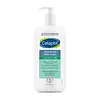What's inside
What's inside
 Key Ingredients
Key Ingredients

 Benefits
Benefits

 Concerns
Concerns

 Ingredients Side-by-side
Ingredients Side-by-side

Salicylic Acid 2%
MaskingBenzyl Alcohol
PerfumingButyrospermum Parkii Butter
Skin ConditioningCocamidopropyl Betaine
CleansingGlycerin
HumectantGlycine Soja Oil
EmollientGuar Hydroxypropyltrimonium Chloride
Skin ConditioningHydrogenated Soybean Oil
EmollientHydroxypropyl Starch Phosphate
Lactic Acid
BufferingLauric Acid
CleansingPalmitic Acid
EmollientPhenoxyethanol
PreservativeSodium Benzoate
MaskingSodium Chloride
MaskingSodium Hydroxide
BufferingSodium Lauroyl Glycinate
CleansingSodium Lauroyl Isethionate
CleansingStearic Acid
CleansingTetrasodium EDTA
Water
Skin ConditioningSalicylic Acid 2%, Benzyl Alcohol, Butyrospermum Parkii Butter, Cocamidopropyl Betaine, Glycerin, Glycine Soja Oil, Guar Hydroxypropyltrimonium Chloride, Hydrogenated Soybean Oil, Hydroxypropyl Starch Phosphate, Lactic Acid, Lauric Acid, Palmitic Acid, Phenoxyethanol, Sodium Benzoate, Sodium Chloride, Sodium Hydroxide, Sodium Lauroyl Glycinate, Sodium Lauroyl Isethionate, Stearic Acid, Tetrasodium EDTA, Water
Water
Skin ConditioningDecyl Glucoside
CleansingGlycerin
HumectantDisodium Cocoamphodiacetate
CleansingCocamidopropyl Hydroxysultaine
CleansingAcrylates/C10-30 Alkyl Acrylate Crosspolymer
Emulsion StabilisingCocamidopropyl Dimethylamine
EmulsifyingSalicylic Acid
MaskingHelianthus Annuus Seed Oil
EmollientCarthamus Tinctorius Seed Oil
MaskingOlea Europaea Fruit Oil
MaskingPhenoxyethanol
PreservativeSodium Hydroxide
BufferingEthylhexylglycerin
Skin ConditioningTetrasodium Glutamate Diacetate
Polysorbate 80
EmulsifyingWater, Decyl Glucoside, Glycerin, Disodium Cocoamphodiacetate, Cocamidopropyl Hydroxysultaine, Acrylates/C10-30 Alkyl Acrylate Crosspolymer, Cocamidopropyl Dimethylamine, Salicylic Acid, Helianthus Annuus Seed Oil, Carthamus Tinctorius Seed Oil, Olea Europaea Fruit Oil, Phenoxyethanol, Sodium Hydroxide, Ethylhexylglycerin, Tetrasodium Glutamate Diacetate, Polysorbate 80
 Reviews
Reviews

Ingredients Explained
These ingredients are found in both products.
Ingredients higher up in an ingredient list are typically present in a larger amount.
Glycerin is already naturally found in your skin. It helps moisturize and protect your skin.
A study from 2016 found glycerin to be more effective as a humectant than AHAs and hyaluronic acid.
As a humectant, it helps the skin stay hydrated by pulling moisture to your skin. The low molecular weight of glycerin allows it to pull moisture into the deeper layers of your skin.
Hydrated skin improves your skin barrier; Your skin barrier helps protect against irritants and bacteria.
Glycerin has also been found to have antimicrobial and antiviral properties. Due to these properties, glycerin is often used in wound and burn treatments.
In cosmetics, glycerin is usually derived from plants such as soybean or palm. However, it can also be sourced from animals, such as tallow or animal fat.
This ingredient is organic, colorless, odorless, and non-toxic.
Glycerin is the name for this ingredient in American English. British English uses Glycerol/Glycerine.
Learn more about GlycerinPhenoxyethanol is a preservative that has germicide, antimicrobial, and aromatic properties. Studies show that phenoxyethanol can prevent microbial growth. By itself, it has a scent that is similar to that of a rose.
It's often used in formulations along with Caprylyl Glycol to preserve the shelf life of products.
Salicylic Acid (also known as beta hydroxy acid or BHA) is a well-known ingredient for treating skin that struggles with acne and clogged pores. It exfoliates both the skin's surface and deep within the pores to help clear out buildup, control oil, and reduce inflammation.
Unlike AHAs (alpha hydroxy acids), salicylic acid is oil-soluble. This allows it to penetrate into pores which makes it especially effective for treating blackheads and preventing future breakouts.
Salicylic acid is also known for its soothing properties. It has a similar structure to aspirin and can calm inflamed or irritated skin, making it a good option for acne-prone skin that is also sensitive.
Concentrations of 0.5-2% are recognized by the U.S. FDA as an over-the-counter topical acne product.
It can cause irritation and/or dryness if one's skin already has a compromised moisture barrier, so it's best to focus on repairing that before introducing this ingredient into your routine.
While salicylic acid does not increase sun sensitivity, it’s still important to wear sunscreen daily to protect your skin.
If you are looking for the ingredient called BHA or Butylated Hydroxyanisole, click here.
Learn more about Salicylic AcidSodium Hydroxide is also known as lye or caustic soda. It is used to adjust the pH of products; many ingredients require a specific pH to be effective.
In small amounts, sodium hydroxide is considered safe to use. However, large amounts may cause chemical burns due to its high alkaline.
Your skin has a natural pH and acid mantle. This acid mantle helps prevent harmful bacteria from breaking through. The acid mantle also helps keep your skin hydrated.
"Alkaline" refers to a high pH level. A low pH level would be considered acidic.
Learn more about Sodium HydroxideWater. It's the most common cosmetic ingredient of all. You'll usually see it at the top of ingredient lists, meaning that it makes up the largest part of the product.
So why is it so popular? Water most often acts as a solvent - this means that it helps dissolve other ingredients into the formulation.
You'll also recognize water as that liquid we all need to stay alive. If you see this, drink a glass of water. Stay hydrated!
Learn more about Water